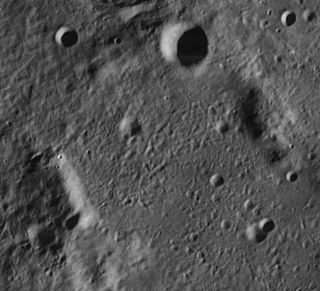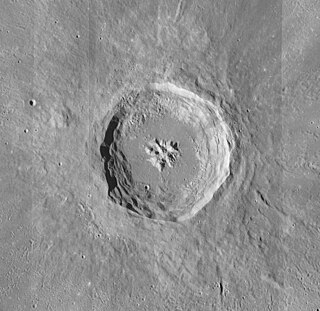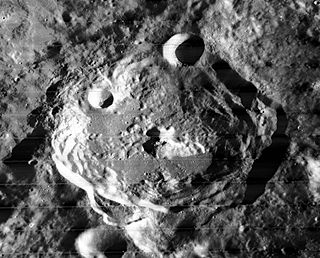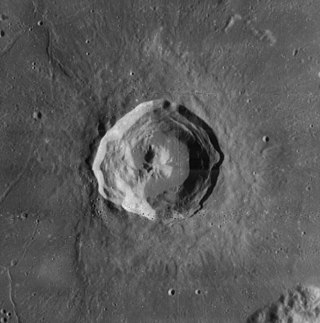
Anaximander is a lunar impact crater that is located near the northwest limb of the Moon. It is joined at the northern rim by the crater Carpenter, a younger and better-defined formation. To the southeast is the much larger J. Herschel, a formation of the variety known as a walled plain.

Anaxagoras is a young lunar impact crater that is located near the north pole of the Moon. It lies across the larger and more heavily worn crater Goldschmidt. To the south-southeast is Epigenes, and due south is the worn remains of Birmingham.

Rutherfurd is a lunar impact crater located entirely within the southern rim of the much larger crater Clavius. The crater Porter is located to the north-northeast of Rutherfurd, on the northeastern rim of Clavius. Rutherfurd forms the larger member in an arcing chain of craters of decreasing size that curves across the floor of Clavius. The craters in this chain do not appear to be the same age, so this formation is most likely random in nature.

Faraday is a lunar impact crater in the southern highlands of the Moon. It was named after British chemist and physicist Michael Faraday. It lies across the southeast rim of the larger crater Stöfler, and the northwest rim of Faraday forms a wide rampart across the otherwise flat floor of Stöfler. To the east of Faraday is Maurolycus.

Aristillus is a prominent lunar impact crater that lies in the eastern Mare Imbrium. It was named after Greek astronomer Aristyllus. Directly to the south is the smaller crater Autolycus, while to the southwest is the large Archimedes. To the northeast are the craters Theaetetus and Cassini.

Autolycus is a lunar impact crater that is located in the southeast part of Mare Imbrium. The crater is named after the ancient Greek astronomer Autolycus of Pitane. West of the formation is Archimedes, a formation more than double the size of Autolycus. Just to the north is Aristillus, and the outer ramparts of these two craters overlap in the intermediate stretch of the lunar mare.

Eudoxus is a prominent lunar impact crater that lies to the east of the northern tip of the Montes Caucasus range. It is named after the Greek astronomer Eudoxus of Cnidus. It is located to the south of the prominent crater Aristoteles in the northern regions of the visible Moon. To the south is the ruined formation of Alexander, and the small crater Lamèch lies to the southwest.

Römer is a lunar impact crater that is located to the north of the Sinus Amoris in the northeast section of the Moon. It was named after Danish astronomer Ole Rømer. It lies in the southwestern part of the mountainous region named the Montes Taurus. It was unofficially named as Atatürk by astronomer Hugh Percy Wilkins in his lunar map, possibly due to the fact that the Montes Taurus are located in Turkey. To the west-northwest is the crater-bay Le Monnier, on the eastern edge of Mare Serenitatis.

O'Day is a prominent lunar impact crater that is located on the far side of the Moon. It intrudes into the northwestern edge of Mare Ingenii, and the rim is lower on that side. To the northwest is the crater pair of Holetschek and Sierpinski. Southwest of O'Day lies the crater Seidel. It is named in honour of the American physicist Marcus O'Day.

Bürg is a prominent lunar impact crater in the northeast part of the Moon. It lies within the lava-flooded, ruined crater formation designated Lacus Mortis. To the south and southeast is the crater pair Plana and Mason. To the west, beyond the rim of Lacus Mortis, is the prominent crater Eudoxus.

Harpalus is a young lunar impact crater that lies on the Mare Frigoris, at the eastern edge of the Sinus Roris. To the southeast at the edge of the mare is the small crater Foucault, and to the northwest on the opposite edge is the walled plain named South.

Milne is a large lunar crater that is located in the southern hemisphere on the far side of the Moon, named after the British mathematician and astrophysicist Edward Arthur Milne. It lies to the northeast of the Mare Australe, and southeast of Lacus Solitudinis.

Schomberger is a prominent lunar impact crater that lies in the southern part of the Moon, in the area near the limb. It is located to the southwest of the crater Boguslawsky, and southeast of Simpelius. The relatively young satellite crater Schomberger A is nearly attached to the southern rim, and the much-aged Schomberger C lies just off the western rim.

Philolaus is a lunar impact crater that is located in the northern part of the Moon's near side. It lies within one crater diameter to the east-southeast of the flooded crater Anaximenes, and to the west of the smaller Anaxagoras. It overlies the older and heavily worn Philolaus C to the south.

Dryden is a lunar impact crater that is located on the southern hemisphere on the far side of the Moon. It lies within the huge walled plain called Apollo, and is one of several features within that basin named after people associated with the Apollo program. Apollo itself has an inner ring, and Dryden is attached to the west-northwest part of that circular mountain formation. To the south of Dryden along the same range is the crater Chaffee.

Crookes is a lunar impact crater that lies on the Moon's far side as seen from the Earth. It lies just to the southwest of the giant crater Korolev. To the southwest of Crookes is McKellar.

Dyson is a lunar impact crater, 63 kilometers in diameter, that lies on the far side of the Moon, past the northwest limb. It is located in the northern part of the surface, to the northwest of the crater Coulomb, and east of van't Hoff.

Hayn is a lunar impact crater that lies next to the northeast limb of the Moon. This location restricts the amount of detail that can be viewed from the Earth, as the western inner side is permanently hidden from sight. Observation of this crater can also be affected by libration, which can completely hide this crater from sight.

Das is a lunar impact crater on the far side of the Moon. It is located to the north-west of the walled plain Chebyshev. To the south-west of Das is the irregular crater Mariotte, and Von der Pahlen lies to the east-northeast. The crater was named after Indian astronomer Anil Kumar Das.

Finsen is a lunar impact crater that is located in the southern hemisphere, on the Moon's far side. It is attached to the southeastern exterior of the walled plain Leibnitz, and the ejecta from Finsen covers the southeastern part of Leibnitz's interior floor. To the southwest of Finsen is another walled plain, Von Kármán, partly overlain by Leibnitz.





















